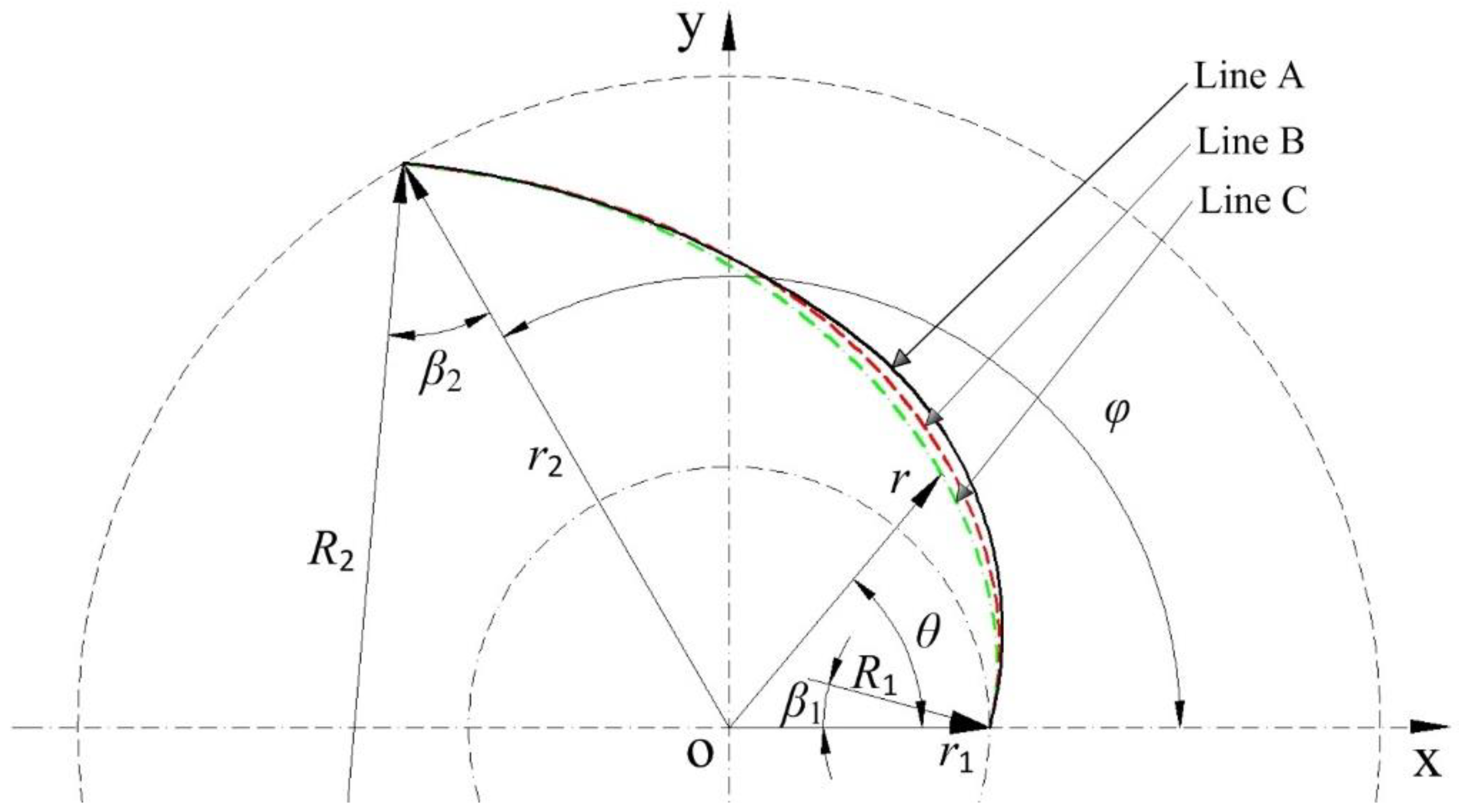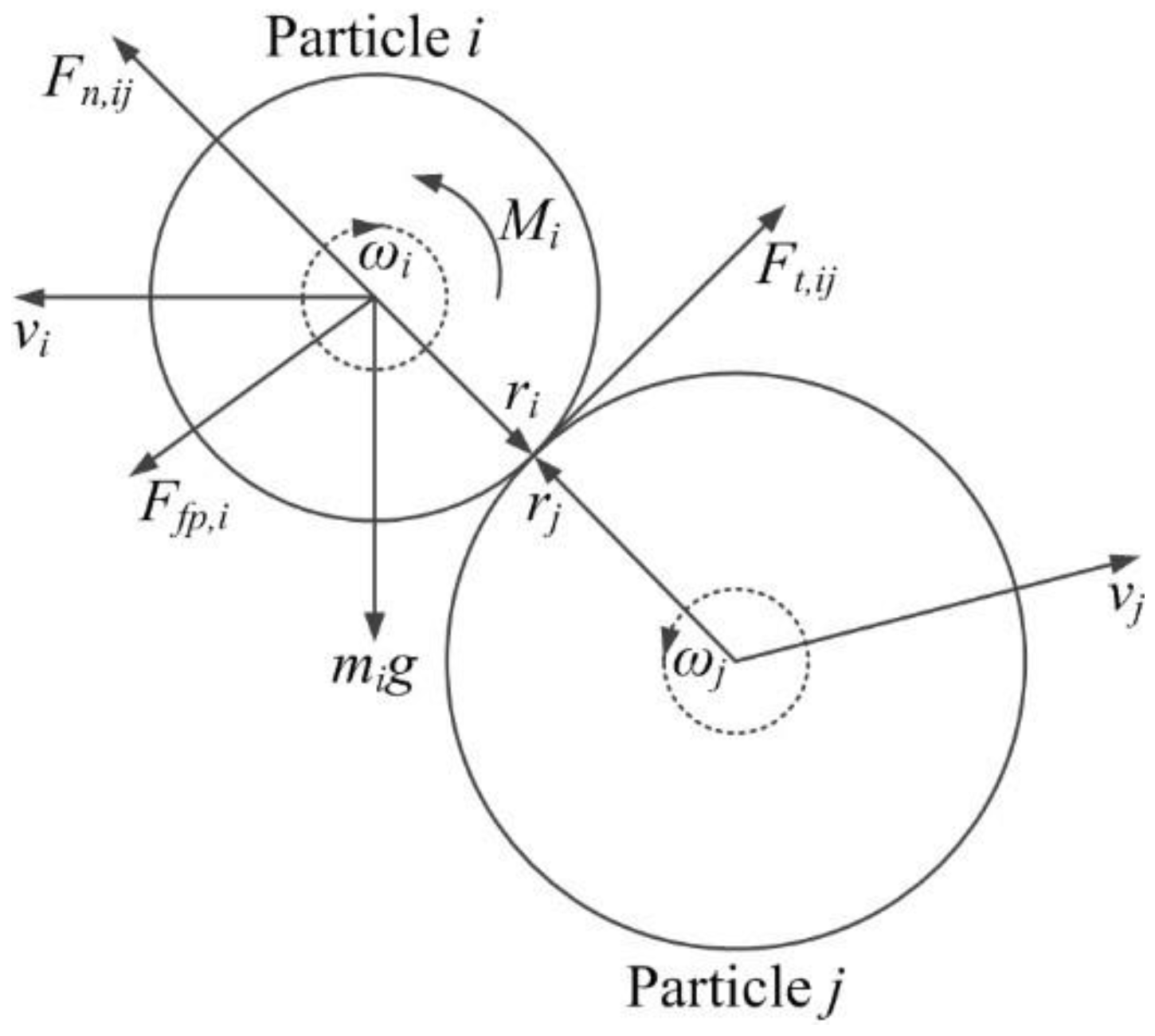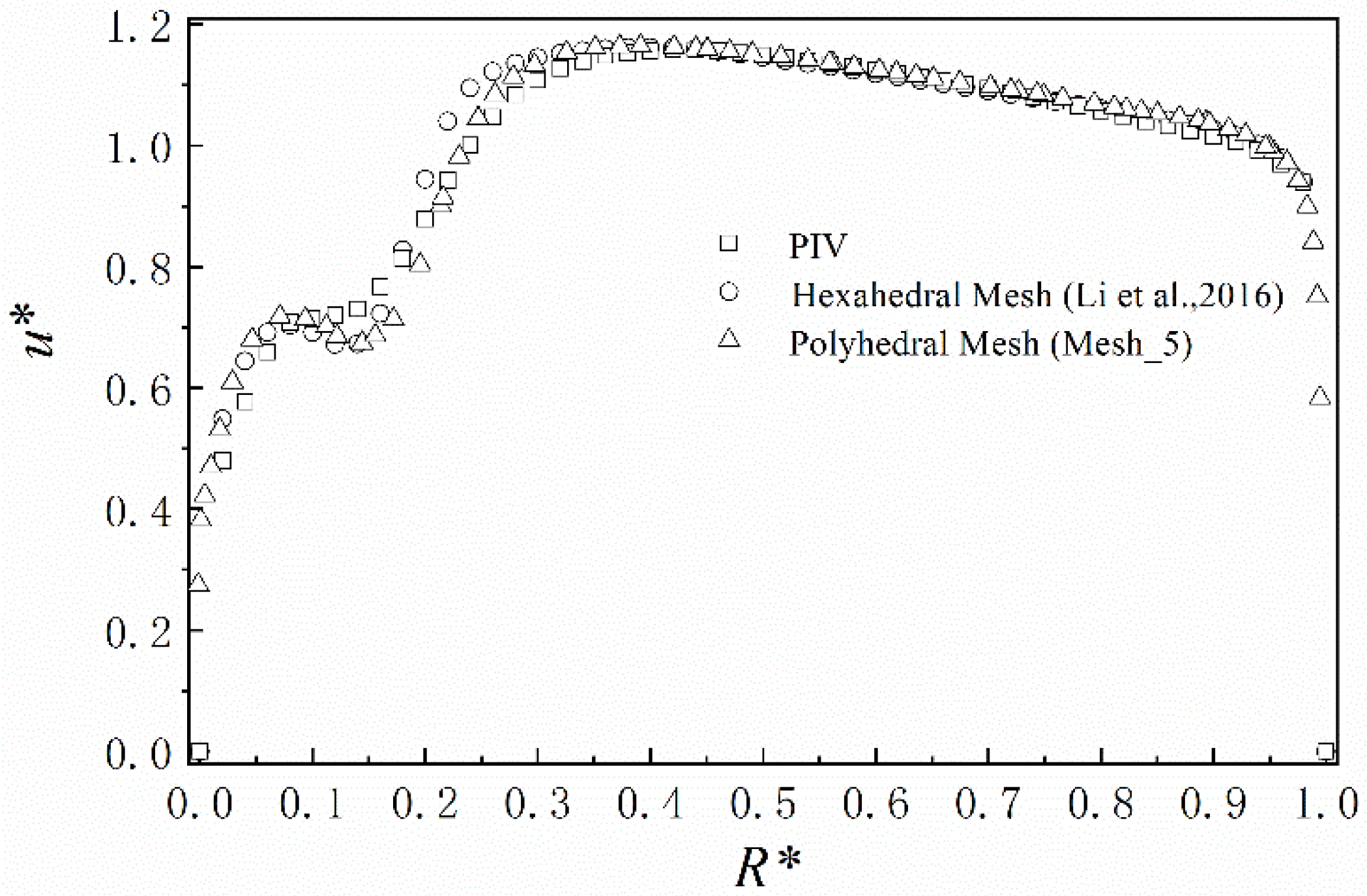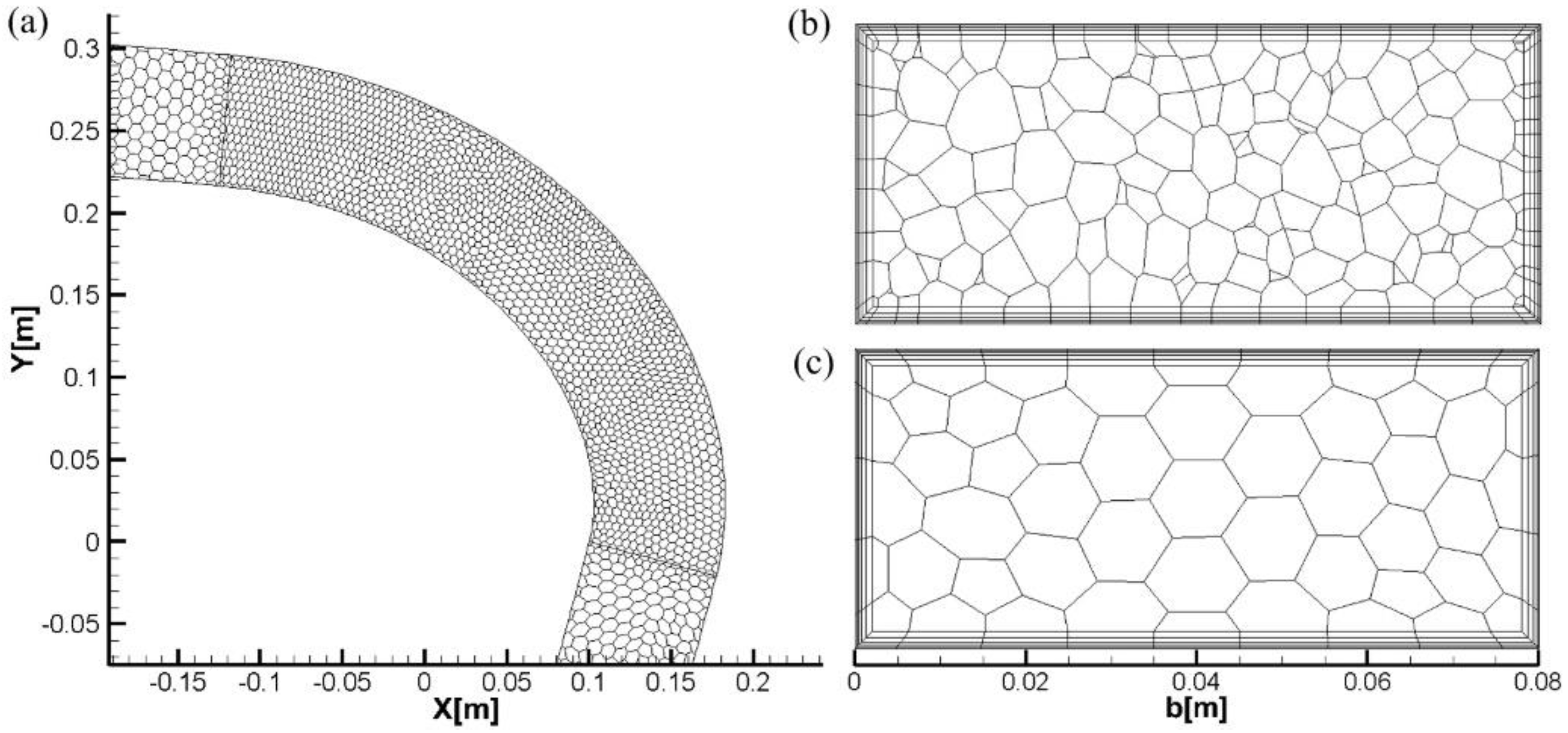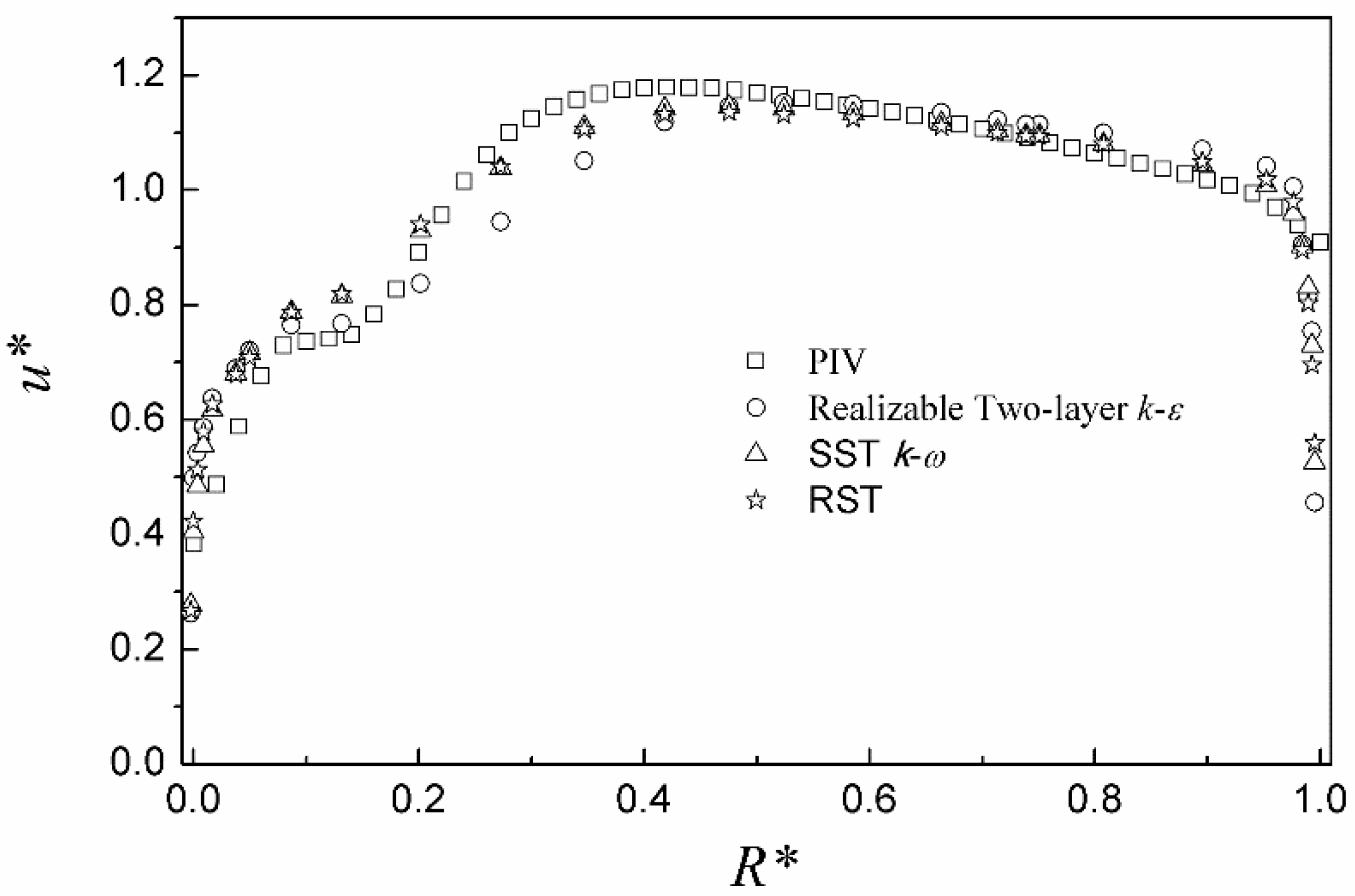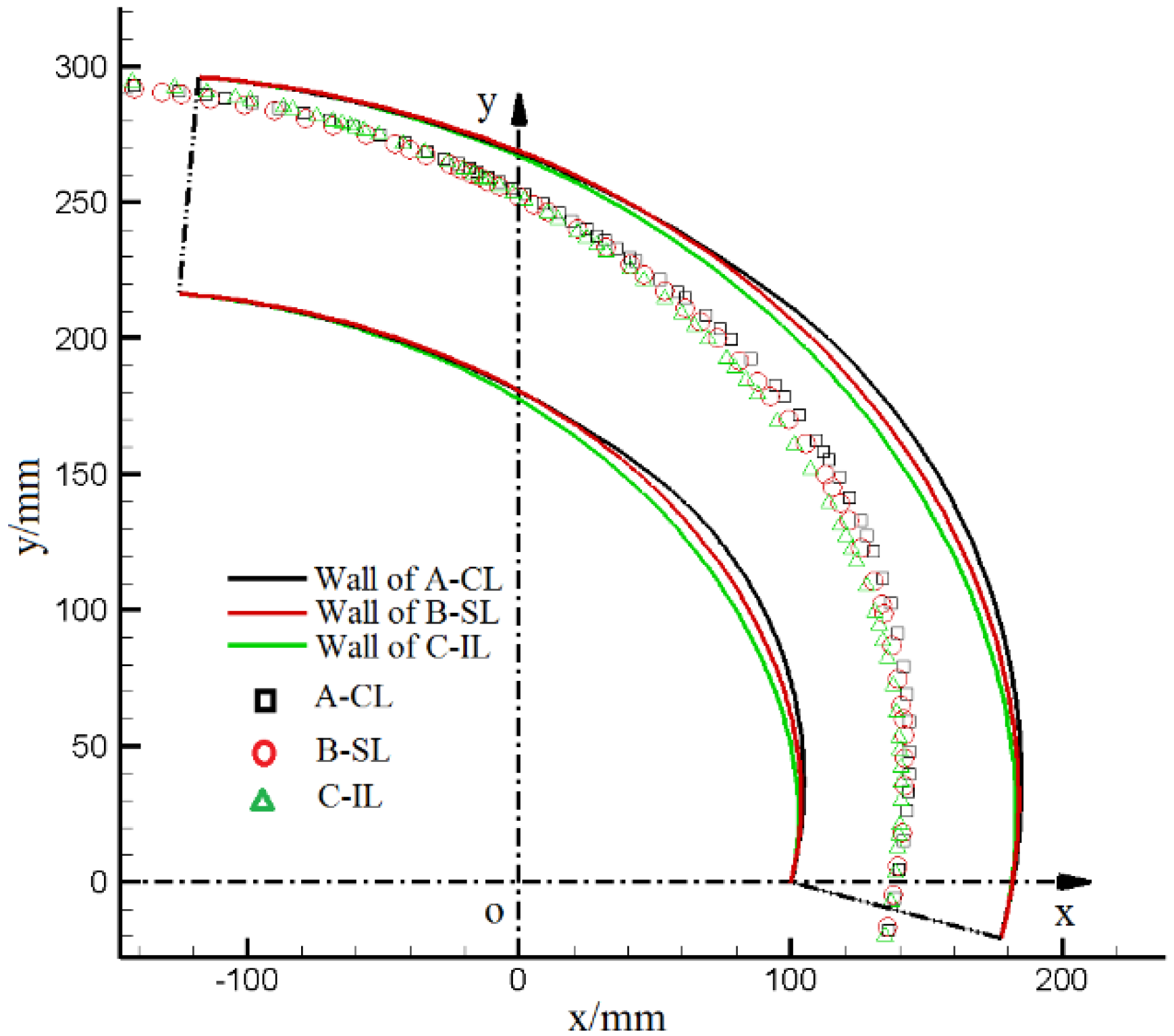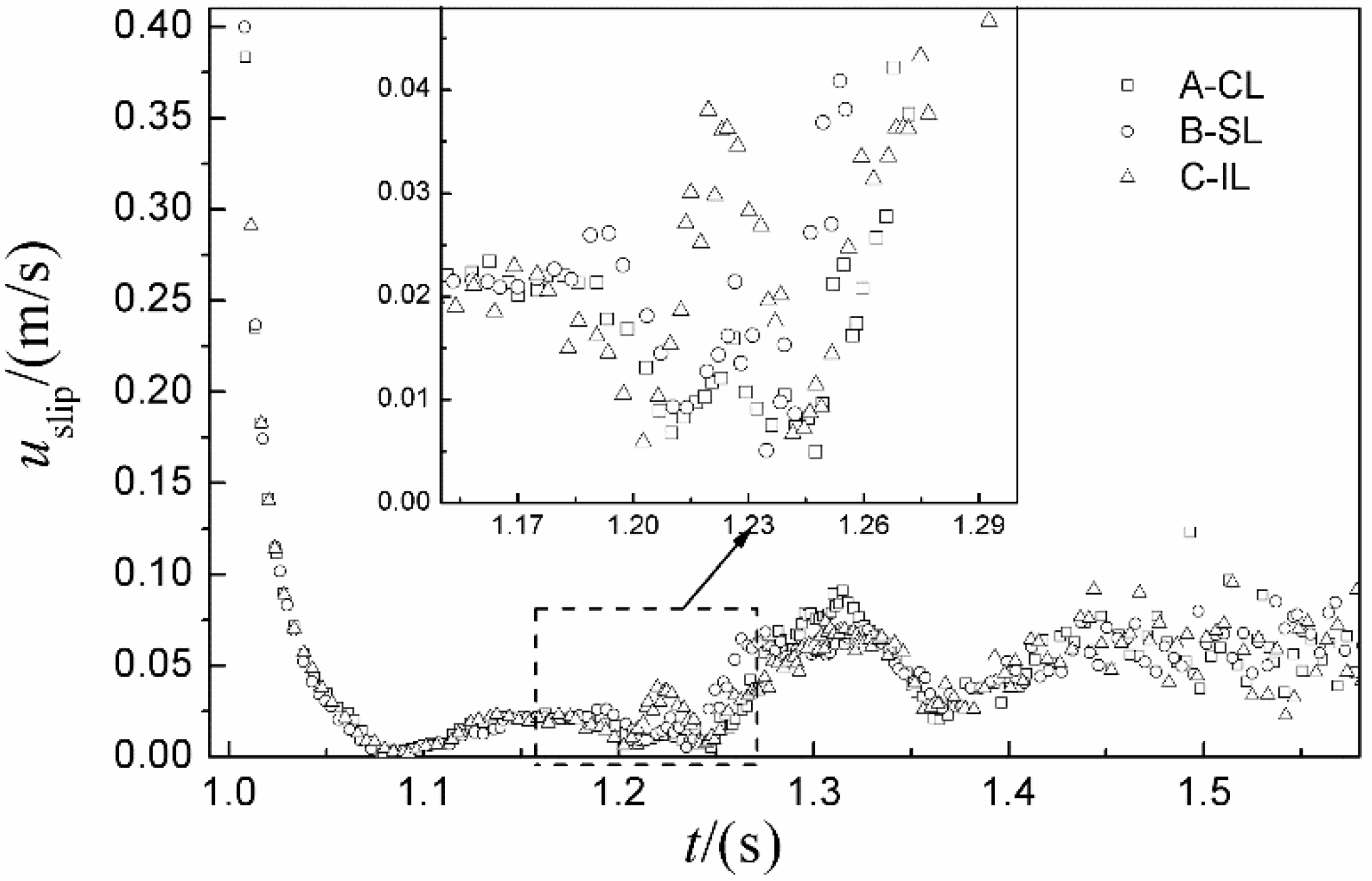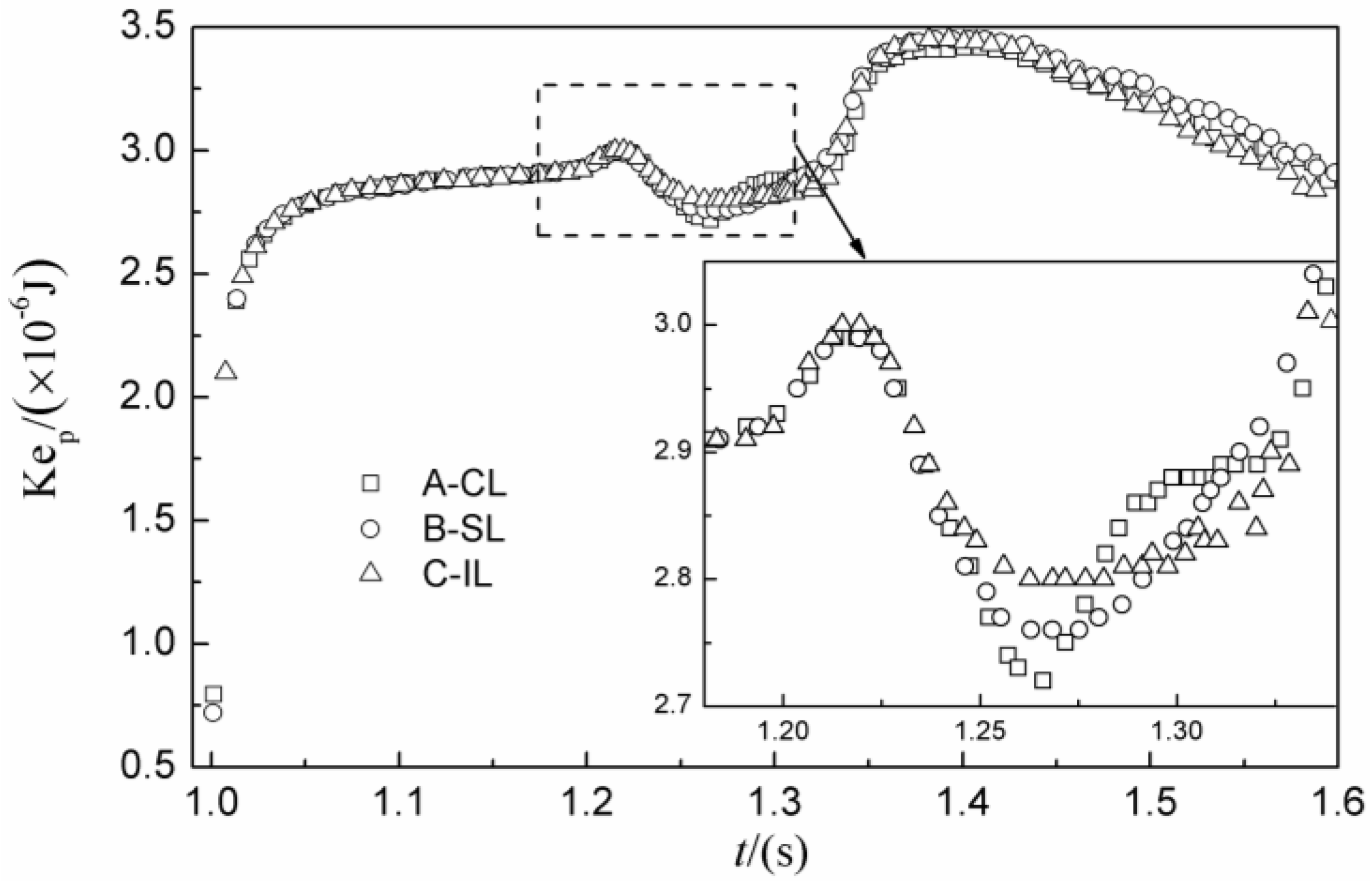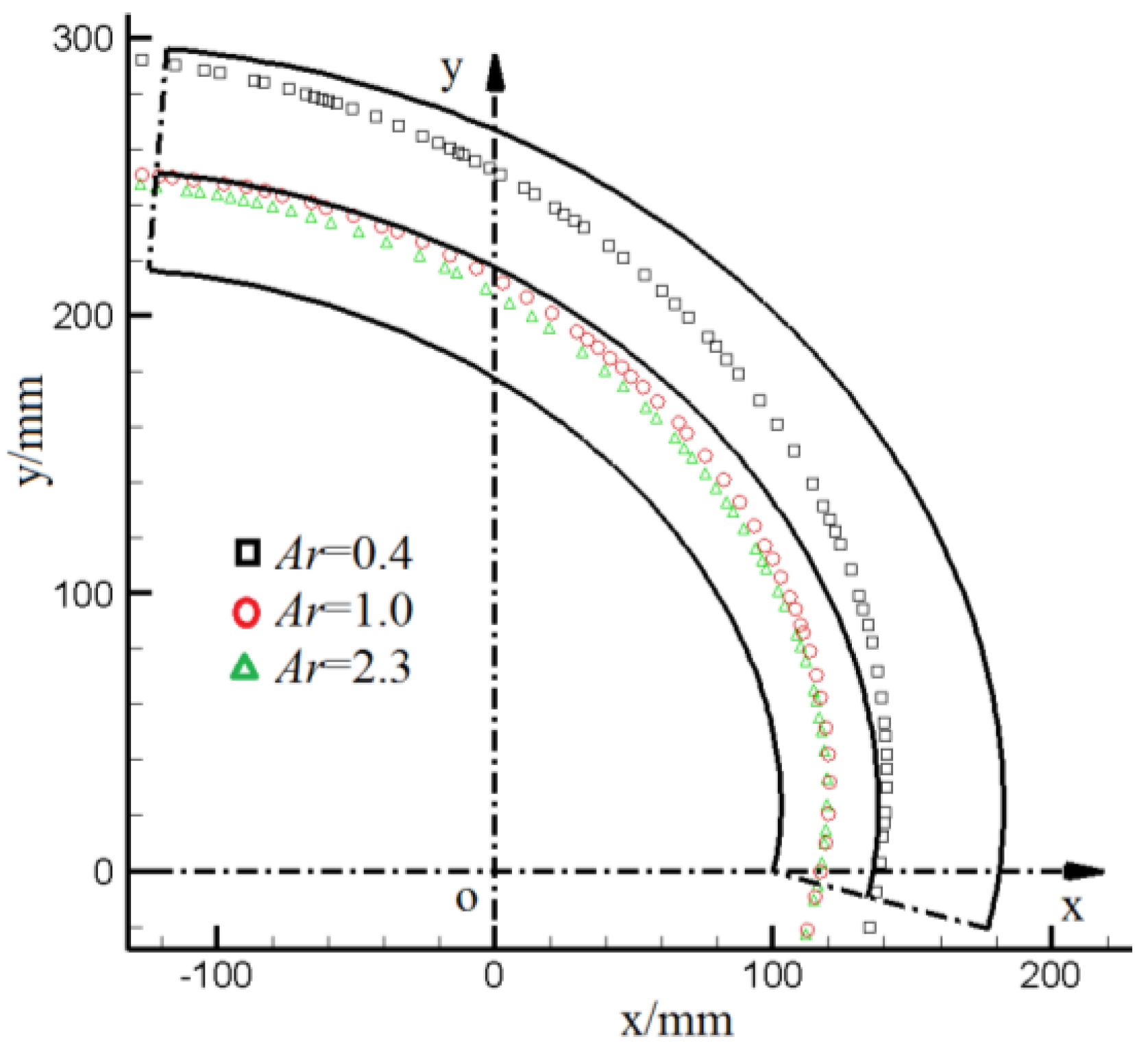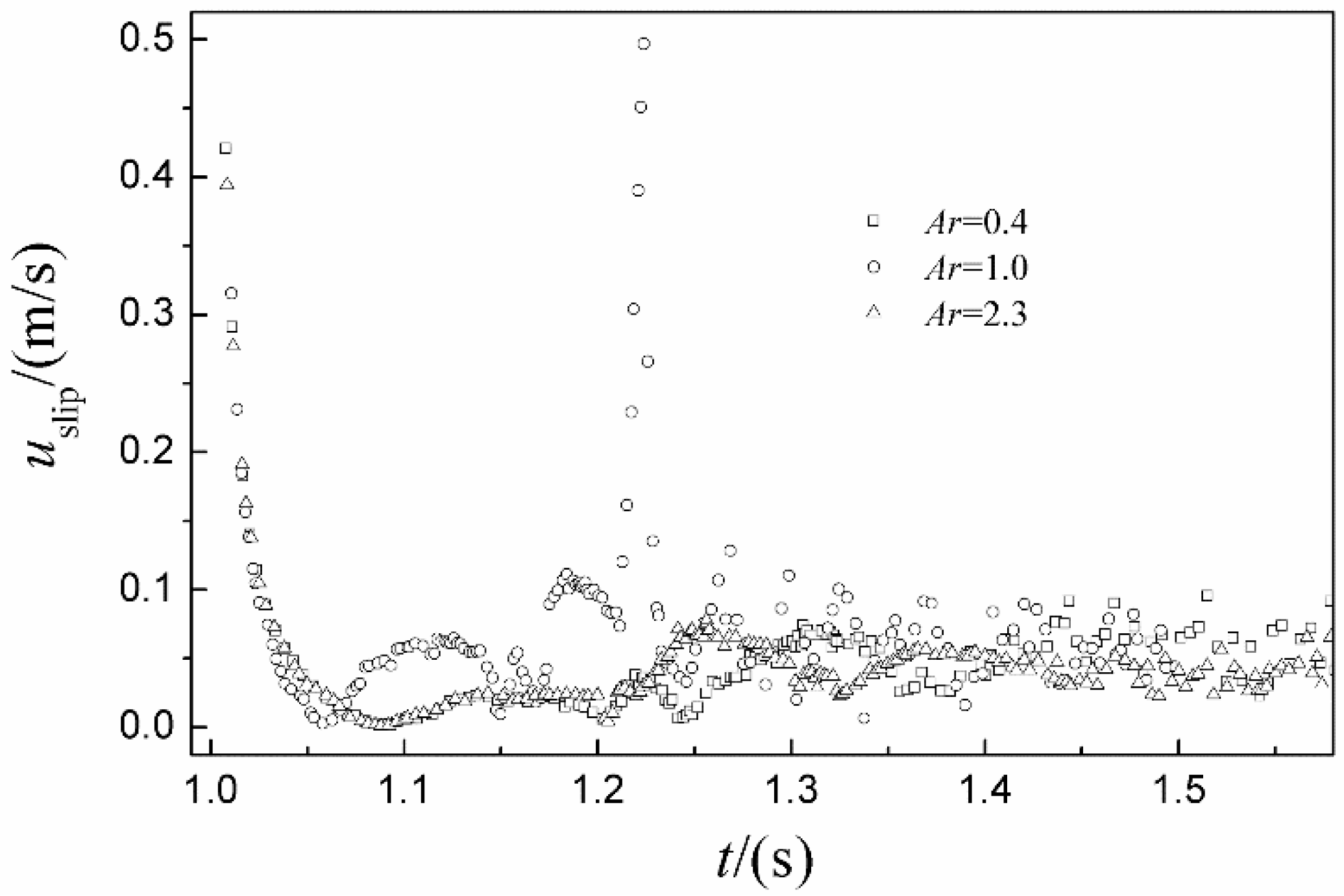1. Introduction
The deep sea is abundant in mineral resources that are scarce on land, and the exploration of marine mineral resources continues to show promising development prospects [
1,
2,
3]. When harvesting marine mineral resources, the transport/flow of particles via pumps is typically involved [
4]. The centrifugal pump is practically irreplaceable in the required conveying system. However, the wear of centrifugal pumps is a major cause of pump failure. More specifically, the wear of flow-passage components in two-phase flow pumps refers to the loss of surface material on the wall of flow-passage components due to the impact of solid particles in the liquid. The degree of wear is closely related to the particle trajectory, particle velocity distribution, and the flow field in the pump. Moreover, the wear of particles can change the performance of the pump, increase flow loss, and aggravate wear, which can affect both the service life and reliability of the pump. Therefore, studying particle wear is important to improve the flow field in two-phase flow pumps.
Many studies of two-phase flow have already been published. Traditional solid-liquid two-phase flow methods (e.g., the two-fluid model of the Euler-Euler method) assume that the solid phase is a continuous pseudo fluid, and local averages are used. Therefore, there are some limitations to the prediction of the non-uniform characteristics of solids. Recently, the CFD-DEM method has been widely applied to study the coupled flow between the solid and continuous phase. The discrete element method (DEM), which was proposed by Cundall [
5,
6,
7], is a display solution method that directly solves discrete particles without the above assumptions. This makes it possible to obtain rich micro particle information—even particle information that is difficult to measure in a test. It tracks the force and motion trajectories of each discrete particle in the system in Lagrange coordinates. The interaction forces between particles (and between particles and wall) are determined by the simplified contact-mechanics model. Therefore, the DEM has the important advantage that it allows the calculation of the flow of particles with a high accuracy as well as the collision behavior of particles. At present, it is mainly used for particle transportation, rock drilling, bucket digging, particle reactions, pipeline wear, etc. [
8,
9,
10].
Due to the advantages of the DEM method with respect to solid particle calculation, many researchers use this method for coupling with a continuous phase [
11,
12,
13]. Zhao [
14] simulated the gas-solid flow in a two-dimensional downer using the CFD-DEM method. Their results showed good agreement with the experimental findings. Afkhami et al. [
15] used the coupled LES-DEM to study turbulent particle-laden flows in a channel. The group results showed that the particle agglomeration is enhanced both in the near-wall region and in the buffer region within the channel. Chen et al. [
16] simulated horizontal pipelines using the CFD-DEM coupling method by conveying different shapes of particles and different concentrations. This was done to obtain the relationship between the effect of the particle characteristics on the flow characteristics. Li et al. [
17] investigated the particle-backflow blockage problem using the CFD-DEM for a single-stage centrifugal pump. The group showed the effect of particle size on a blockage in the pump. Furthermore, Hu et al. [
18] applied the coupled CFD-DEM simulations to clarify the solid-liquid two-phase flow in two-stage centrifugal pumps for different particle sizes with constant particle concentrations. Deng et al. [
19] investigated the hydrodynamic (and coarse) kinetic behavior of the particles in the pump for slurry transfer using the coupled CFD-DEM simulation. The group determined the slurry transport characteristic curves as well as the particle transport and distribution characteristics of six-stage centrifugal pumps. Nonetheless, applications of the CFD-DEM for solid-liquid two-phase pumps are still few or none. The main reason for this is that the calculation process, which is associated with the DEM for liquid-solid coupling, is relatively slow. To solve this problem, a polyhedron grid is used in this paper, which significantly shortened the calculation time.
In fluid machinery, curved channels are commonly used—particularly in pumps [
20,
21]. However, the curvature changes of the channel in the rotating impeller are more complex, and the channel is also affected by the rotation factors. This makes it difficult to accurately predict the flow of the impeller. Compared with the curved channels in hydraulic systems, a simple pipe flow is basically only affected by a single factor. For example, the rotation of the straight pipe is only affected by the rotation speed, and the static curved channel is only affected by the curvature of a single arc. Therefore, the flow channels in fluid machinery can be simplified to curvature flow channels. Many researchers have compared the simplified flow passage with the impeller’s flow passage [
22,
23]. Macfarlane et al. [
24] conducted an experimental study of rotating rectangular tubes with different area ratios to find the relationship between secondary flow and the turbulent boundary layer with a zero-pressure gradient. This provides a reference for the design of a centrifugal impeller. Tsujita et al. [
25] numerically studied the flow in curved pipes (square cross-section) and applied the loss mechanism to the impeller channel. Guleren et al. [
26] used the LES method to compare and study the flow in the transition zone (from turbulence to laminar flow) of the inner axial flow-channel of a straight pipe, a U-pipe, and a typical centrifugal compressor impeller. In addition, the group investigated the effect of both channel curvature and rotation. Casey et al. [
27] proposed a new through-flow method based on the streamline curvature, which was successfully used for the meridional flow-channel (axial plane) of mixed flow pumps and turbines. With this method, both the leading and trailing edges of the blade were rectangular pipes in the study. This has important benefits for the preliminary design of multistage axial flow machinery.
In previous studies [
28,
29], the overall flow development in ducts was studied in depth. This manuscript aims to extend the above design ideas and methods to solid-liquid two-phase flow. The curved channel is used to study the varying curvature profile of the impeller, with the aim of providing a reference for the design of the impeller. In this study, the basic idea of the discrete element method is introduced first. Then, the effect of the polyhedron grid on solid-liquid two-phase coupling is verified, and the CFD-DEM simulation is performed. This is in good agreement with the experimental results. Then, the single-particle motion in the varying curvature elbow is compared and analyzed, and the particle motion law is determined. The effect of the curvature ratio
Cr and the area ratio
Ar on the single-particle motion law are studied. Furthermore, a statistical analysis of the simulation results is carried out.
The paper is organized as follows: the problem description and experiment set-up are clarified in
Section 2.
Section 3 describes the numerical simulation and validation. The effects of the curvature ratio
Cr and the aspect ratio
Ar are analyzed in
Section 4. Conclusions are summarized in
Section 5.
3. Numerical Simulation and Validation
3.1. Numerical Methodology
According to Newton’s second law, the motion of particles can be divided into two different types in a given system: translation and rotation. Particles may collide with adjacent particles or the wall at any time in the process of these two types of motion, and the particles interact with their surrounding fluid to exchange momentum and energy. Therefore, the solution for the solid-liquid two-phase CFD-DEM is divided into three parts: solution of the continuous phase, solution of the discrete phase, and two-phase coupling.
The continuous phase mainly represents a solution of the Navier Stokes equation, and its mass and momentum conservation equations are:
where,
Fpf represents the momentum exchange between the continuous phase and discrete phase. It is a pair of interaction forces, with
Ffp in the motion equation for the discrete phase, which is associated with coupling between two phases.
The discrete phase mainly solves the force in the particle collision process via the contact model. The particle acceleration can be calculated by using Newton’s second law and then updating both the particle velocity and displacement. According to the force analysis of particle
i (see
Figure 4), the corresponding momentum conservation and angular momentum conservation equations are:
where,
mi and
vi are the mass (kg) and velocity (m/s) of particle
i, respectively;
g is the gravity acceleration (m/s
2);
Fn,ij is the normal contact force (N) between particle
i and element
j;
Ft,ij is its tangential contact force (N).
Ii and
ωi are the moment of inertia (kg·m
2) and angular velocity (rad/s) of particle
i, respectively.
ri is the radius of particle
i (m).
Ffp denotes the force from a liquid relative to particle
i (N).
Mi represents the rolling friction torque (N·M).
From the above continuous and discrete phase-governing equations, it is found that interphase interaction occurs between solid and liquid phases, which can exchange mass, momentum, and energy. According to Newton’s third law, the liquid exerts a force on the particles, while the particles can act on the fluid. Therefore, the two-way coupling method was used to describe the interaction between the two phases. In general, the effect of interphase action on the continuous phase can be ignored for dilute-phase particles. Therefore, the Schiller-Naumann drag model is used for the one-way coupling solution in this paper. The force, which is exerted by the fluid on particles, only considers the drag force and pressure gradient force, but ignores the force exerted by other fluids.
3.2. Verification of Grid Scheme
The generation scheme and its independence analysis are shown in
Table 2. With the same simulation settings, the grid schemes in
Table 2 were calculated. The friction coefficients of the import and export were obtained, in which the friction coefficient
f is calculated by the Darcy–Weisbach formula:
where Δ
p is the pressure drop of the inlet and outlet (Pa),
Dh is the hydraulic diameter of the pipeline (m),
L is the length of the centerline of the flow channel (m),
ρ is density (kg/m
3), and
ub is the average velocity (m/s).
Taking the C-IL tube as an example, at Re
b = 1.4 × 10
5, the optimal number of hexahedral meshes is 3–3.5 million cells [
29]. Compared to the same varying curvature pipeline, the number of polyhedral meshes is lower. Therefore, the polyhedron grid appears more suitable for the CFD-DEM. To better understand the benefits of the polyhedral grid, the velocity fields, which were calculated by polyhedral grids and hexahedral grids, are compared with those obtained using PIV. Taking
θ = 80° as an example, the comparison results are shown in
Figure 5.
The dimensionless radius R* = (Ri – RICW)/b. At R* = 0.1~0.25, the dimensionless axial velocity u*, which was calculated using polyhedrons, reached the accuracy for hexahedrons, which is close to the PIV result. Due to the large effect error of the velocity gradient, this reflects the more accurate characteristics for polyhedrons in the calculation gradient and the local flow conditions. At R* = 0.2~0.3, it represents the intersection of the curvature vortex and the basic vortex. Furthermore, the secondary flow-velocity flows back from the inner curvature wall (ICW) to the outer curvature wall (OCW) when the axial velocity increases from the trough to the maximum. In addition, the calculation accuracy with polyhedrons is even higher than for the hexahedron grid.
Even though there are fewer cells in the polyhedron grids, the scheme of Mesh_5 still requires more computing power and time with the CFD-DEM simulation. Therefore, further dilution was carried out based on the grid volume. The simulation accuracy error of Mesh_2 in
Table 3 is 9.1%, but the number of grids is nearly 1/9 of Mesh_5. To fully account for computing accuracy and computing resources, the grid of Mesh_2 was further refined. In the mesh refinement scheme, the effect of boundary layers was taken into account, see
Table 3.
A mixed treatment (all y+ wall treatment) was used to deal with the wall boundary, and the appropriate wall function was automatically selected based on the value of y+. As shown in
Table 3, with increasing thickness of the first layer of the boundary layer, the friction coefficient f also increased. However, the deviation between the axial velocity and PIV became larger, see
Figure 6. At
R* = 0.1~0.5, the larger the y+ value, the larger the error at the predicted flow separation and gradient. Therefore, by carefully weighing the friction coefficient and velocity field prediction results, the polyhedral grid of Mesh_ 2 was selected. The thickness of the first layer of the boundary layer was 1.5 × 10
−4 m, and its y+ value was in the range 0.4~10.6. In addition, the curvature elbow section was refined. The final volume grid is shown in
Figure 7, and the relative error of the accuracy of the friction coefficient
f was 8%. The solution-finding time was reduced by nearly 1/10, and its simulation accuracy was within an acceptable range.
3.3. Validation of Turbulence Model
Using the C-IL tube as the test object, the realizable two-layer
k-
ε model, SST
k-
ω model, and Reynolds stress model (RST) were selected for coupling with DEM. At Re
b = 1.4 × 10
5, the friction coefficient
f was obtained by using the above three turbulence models, as shown in
Table 4. The relative error of the friction coefficient predicted by the SST
k-
ω model was the smallest, less than 10%, while the relative error of the realizable two-layer
k-
ε model was the largest, followed by the RST model.
Figure 8 shows the axial velocity of three turbulence models at
θ = 80° compared with PIV results. As shown in
Figure 8, there are differences between the predicted
u* of the three models and the PIV results at the positions of the ICW curvature vortex and basic vortex (
R* = 0.1~0.4). The error of maximum axial velocity
ua,max predicted by the realizable two-layer
k-
ε model was the largest, while the other two models were very close.
3.4. Numerical Set-Up
In this study, the continuous phase for a single particle was solved using the Euler method, and the discrete phase was solved with the Lagrange method. Moreover, the Hertz-Mindlin non-sliding contact model was adopted for the discrete phase collision. STAR-CCM+ was used for the polyhedron mesh generation, and unsteady calculation was used for the simulation in this paper. The SST
k-
ω model was selected as the turbulence model. The boundary conditions were uniform flow velocity at the inlet of the curved duct, applied no-slip boundary conditions on the duct walls, and a pressure outlet condition of the curved duct. The unsteady calculation for clean water was performed in 0 ~ 1 s, and the release of single particles started at 1 s. The time for particles to leave the pipeline was at least 1 s. Therefore, the simulation time was set to 3 s. In this way, particles can complete the simulation calculation of the complete flow in the pipeline. The single particle was set to spherical, and its diameter was
dp = 1 mm. The physical and mechanical properties of the particles are shown in
Table 5. The release position was the middle of the ducts. The fluid density was
ρp = 1000 kg/m
3 and the Reynolds number was Re
b = 1.4 × 10
5.

